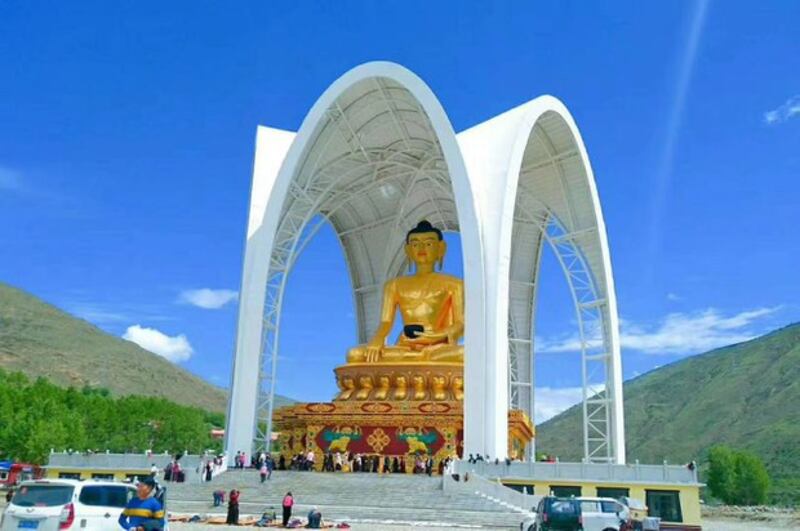In this satellite image slider, the 99-foot Buddha statue in Drago in the Tibetan Autonomous Prefecture is shown at left sheltered by a white canopy on Nov. 19, 2019. At right is the site on Jan. 1, 2022. Credit: Planet Labs with analysis by RFA
Updated at 08:55 a.m. EST on 2022-01-06
Authorities in China’s Sichuan province last month forced Tibetan monks and other local residents to watch the demolition of a large and venerated Buddha statue following official complaints that the statue had been built too high, Tibetan sources said.
Destroyed along with the 99-foot tall statue in Drago (in Chinese, Luhuo) county in the Kardze (Ganzi) Tibetan Autonomous Prefecture were 45 traditional prayer wheels set up for use by Tibetan pilgrims and other worshipers, sources said.
RFA verified the destruction of the statue by analysis of commercial satellite imagery. Chinese authorities forced monks from Thoesam Gatsel monastery and Tibetans living in Chuwar and other nearby towns to witness the demolition, which began on Dec. 12 and continued for the next nine days, Tibetan sources in exile said, citing contacts in the area.
Chinese authorities forced monks from Gaden Namgyal Ling monastery and Tibetans living in Chuwar and other nearby towns to witness the demolition, which began on Dec. 12 and continued for the next nine days, Tibetan sources in exile said, citing contacts in the area.
“Local Tibetans from other villages were also forced to come to watch the demolition,” one Tibetan living in India said, speaking on condition of anonymity to protect family members still living in Drago. “A lot of police had also been deployed to make sure that spectators didn’t take pictures or videos or create disturbances.”
“It was just like the [1966-76] Cultural Revolution, when the Chinese government destroyed everything that was old in Tibet,” he said.
“Along with the Buddha statue, the prayer wheels erected near Drago monastery were also destroyed, and the way they orchestrated this demolition was very disrespectful,” another Tibetan living in India said, also speaking anonymously in order to protect his sources.
Drago county chief Wang Dongsheng, director of the demolition, had earlier overseen a campaign of destruction at Sichuan’s sprawling Larung Gar Buddhist Academy in a move that saw thousands of monks and nuns expelled and homes destroyed, the source said.
“Now we are seeing the same kind of destruction here in Drago and restrictions placed on Tibetans in the region,” he said.

No word has been received on when the destruction was completed, the source said. “But it is a fact that the statue is now almost completely destroyed and that local Tibetans were forced to watch these events, with authorities saying this would teach Tibetans a lesson.”
With construction completed on Oct. 5, 2015, the Buddha statue in Drago had been built with contributions of around 40 million yuan (U.S. $6.3 million) by local Tibetans and was designed to withstand earthquakes, said a former Drago resident named Palden, now living in India.
“And it had the full approval of the local authorities,” Palden said, adding that Chinese authorities later withdrew their approval and said the statue had been built too high.
“But in reality, their intention is to completely destroy Tibet’s identity by eradicating Tibetan religion and culture,” he said.
Translated by Tenzin Dickyi for RFA’s Tibetan Service. Written in English by Richard Finney.
CORRECTION: Changes the name of the monastery whose monks were forced to watch the demolition to Gaden Namgyal Ling.
